Ham Radio, callsign G8FWY
I recently got back into Ham Radio, after a short break of about 12 years. ( In which time I built about 7 engines.)
I bought a SDR 'dongle' on Ebay for about £20. This, with the addition of an aerial and a computer, forms a very simple radio receiver which covers about 500Khz to 1700Mhz.
If only it was that simple! You need an extremely efficient aerial and some clever software to make it work. Ok, the software is free and you will be able to hear stuff, but it's no match for a 'proper' receiver.
Shortly after this foray, I found a transceiver kit known as Ubitx on the net. This covered all of the short wave bands and was remarkably cheap at $129. This kit consisted of two boards, already made up and a few bits 'n pieces.
The kits are put together in India, giving valuable employment to the ladies who solder them up. They must have better eyesight than me - all the components are surface mount devices.
Anyway, I ordered one at a total cost of £104 including shipping and it arrived within 4 days. ( The Chinese can't come anywhere near that! ). Talking of the Chinese, I ordered a case to put the kit into and, yes you guessed, it came from China. Took about 2 weeks!
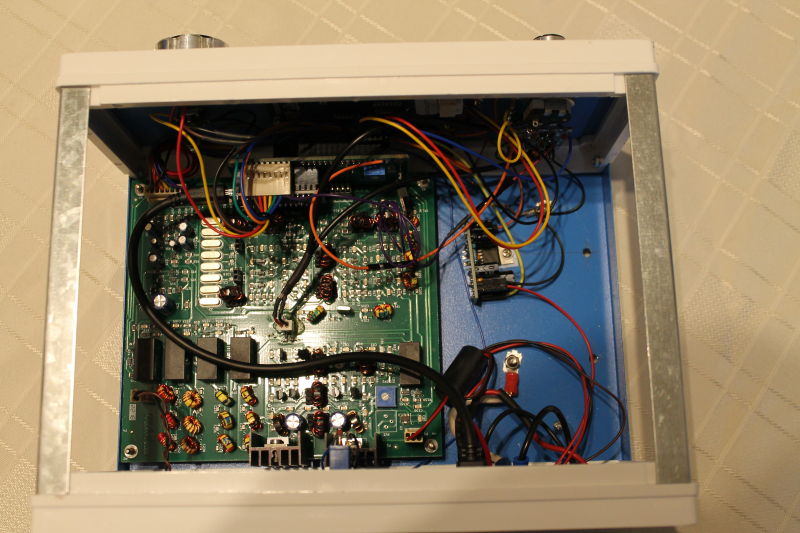
The inside view of the Ubitx transceiver.
The Ubitx is deliberately designed down to a price. The designer, Ashar Farhan, intended it for the Indian ham market, where money for hobbies is always a problem. Consequently the builder has to be aware that it isn't perfect and a fair amount of time is needed to 'tame' it.
There is a forum on the 'net dedicated to modifying and improving the Ubitx and I got a lot of valuable information and help from them.
The set is controlled by a tiny computer ( an Arduino, for those in the know!) and there are several versions of software available to 'drive' it.
The first modification I did was to add a 2.8 inch touch screen and the appropriate software. This really improves things from an operational point of view. After that I added and extra audio amplifier as the set is a bit quiet.
The next modifications really stretched me to my limits! Many years ago when I was working, I was regarded as 'expert' at soldering and in fact used to train junior engineers. I was also very proficient with smd's - surface mount devices - having designed and built several pieces of equipment with this technology.
Not any more! My eyes aren't good enough and my hands shake. No good for smd's.
I did one modification to the main board, replacing a few smd components and only just got away with it.
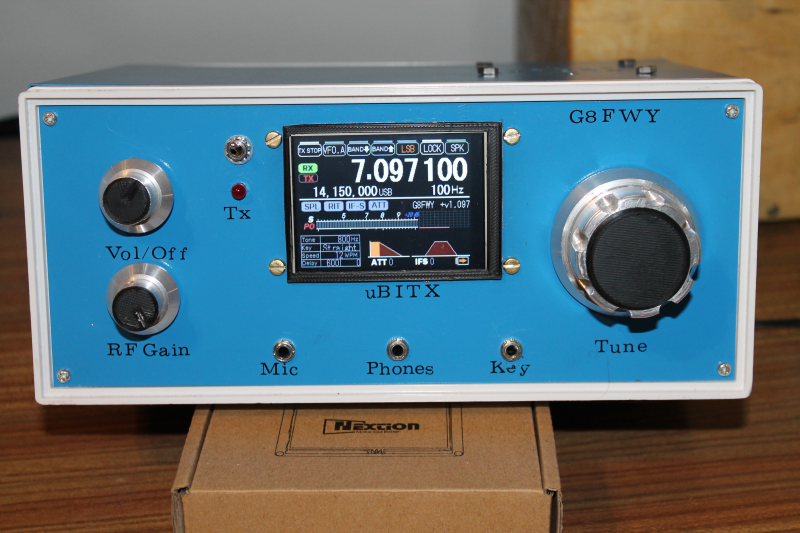
Front view.
While the Ubitx worked very well, it was clear that I would need to do a fair amount of modifications to it. It was also clear that in order to set it up correctly I would need some expensive test gear. This never used to be a problem when I was working, I would just go in to work on my day off and use the equipment. Can't do that anymore either! But this isn't all negative. It had rekindled my fascination with ham radio and for that, I'm grateful.
I was idly browsing on Ebay when I came across a transceiver which was very similar to the one I had 12 years ago. It was a Yaesu FT 950 ( I used to have the FT 920 ). It was up for a decent price, so I offered him a bit less and also offered to go to Carlisle to pick it up. He accepted, so I duly went to Carlisle and the gent gave me a demonstration. He powered it from a 12V 30A power supply, so I offered him an extra £50 and he agreed to sell the power supply as well.
I came home very happy.
In the meantime, I offered the Ubitx for sale on the 'net. It went very quickly ( I had 4 people after it ) and I made only a small loss.
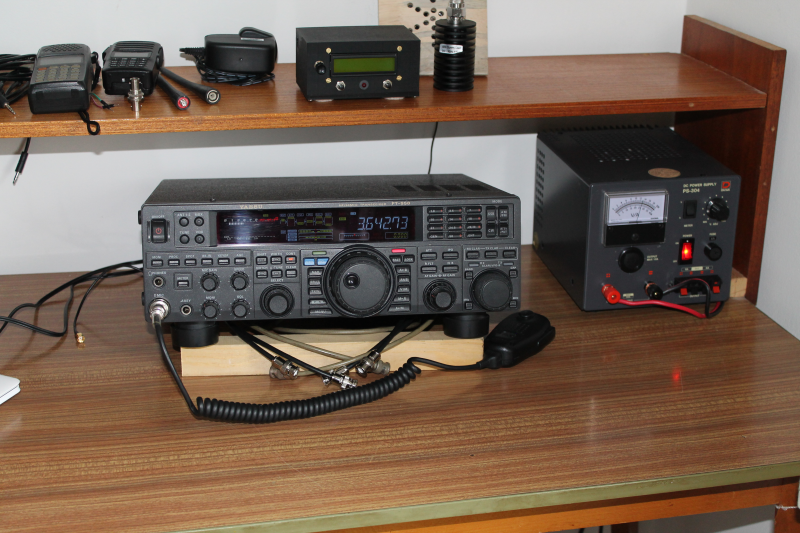
The ham radio corner with the FT 950 and immediately above that, an arduino based power / swr meter.
At this time I was using a 2metre / 70 centimetre collinear and a nest of 4 paralleled dipoles for the 10, 15,20 and 40 metre bands. I also strung up a wire around the periphery of my garden, fed at the centre of one leg and split at the opposite point. This, rather remarkably, turned out to be resonant on the 80 metre band.
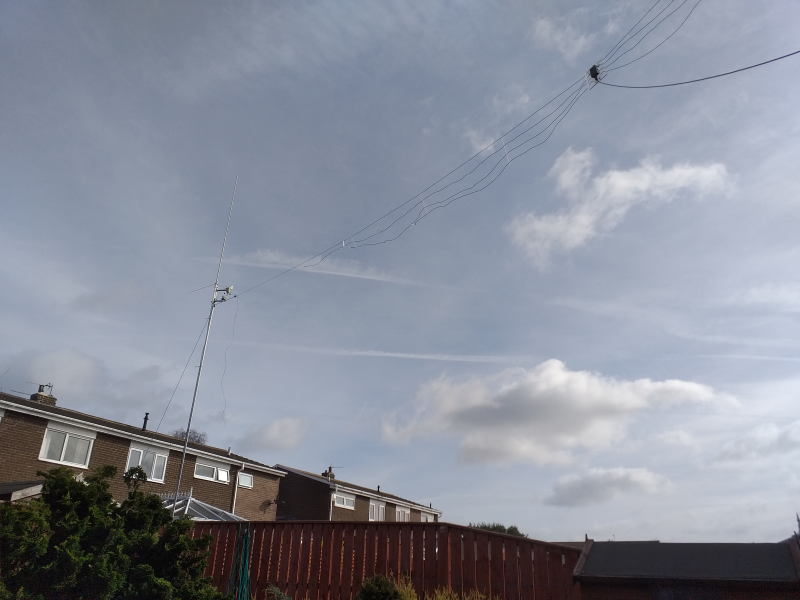
The nest of dipoles and the collinear.
I ran this setup for about a year and I really wasn't satisfied with its performance, so I decided to change things about a bit.
As the FT950 only covered the bands up to 50Mhz, I bought a FT991 which covered all the HF bands as well as 50, 144 and 423 Mhz. I thought I might try a vertical HF aerial so I got a Hustler 5BTV. The VHF side of the station relied entirely on a collinear at the far end of the garden ( with a loss of about 3db in the RG58 feeder ), so again, I decided to change things.
I ordered an aluminium telescopic mast 6 metres high in the low position and 11.5 meters when raised and topped it off with a 3 element 6 metre beam, a 5 element 2 metre beam and a 10 element 70 cms beam and mounted the collinear on top.
I now have a station which performs very well.
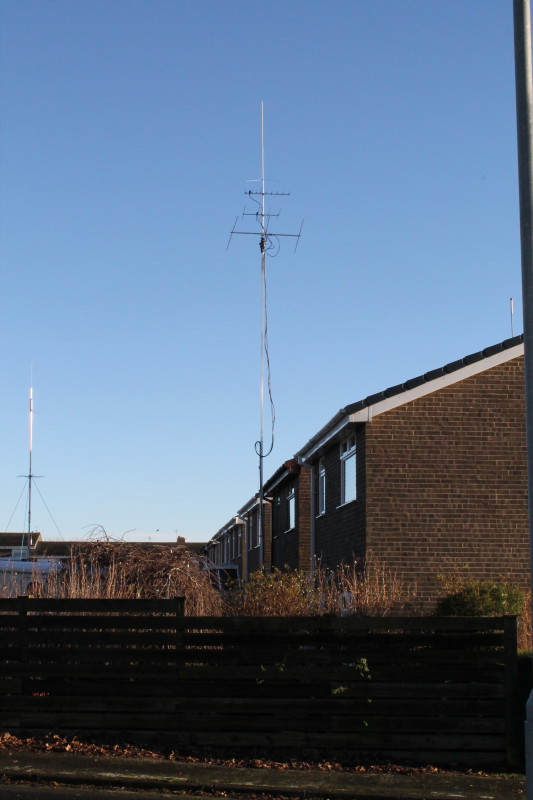
The Hustler vertical (left) and the mast raised to full height.
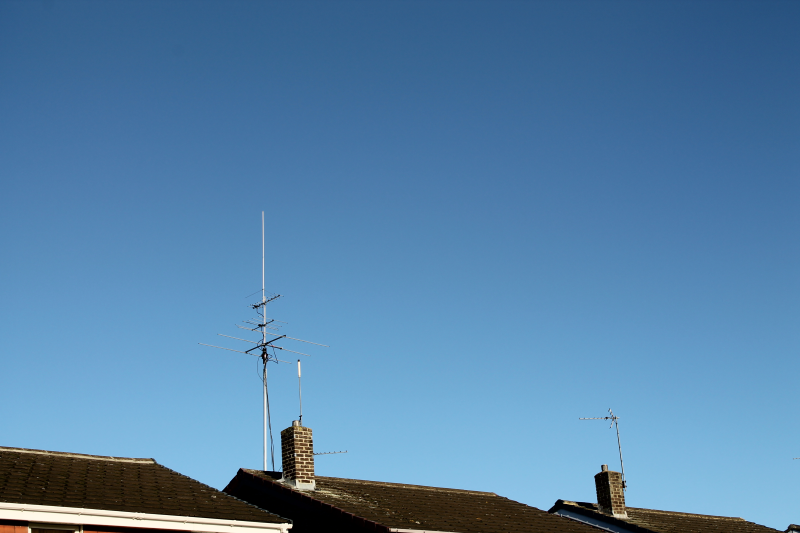
The street view of the raised aerials.
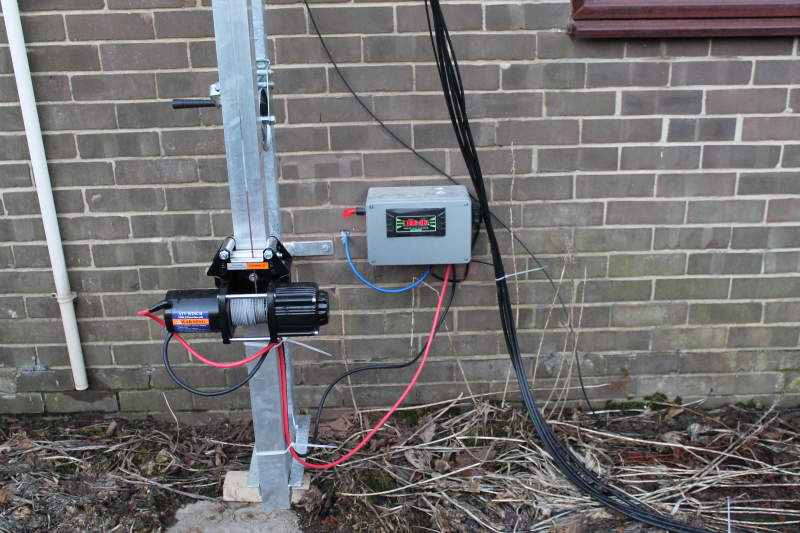
The winch and its control box - saves a lot of winding!.
The winch is remotely operated, so I can sit in my operating position and wind it up or down.
You might notice that the winch cable has a daub of red paint on it. That tells me its fully up. There's another one at the other end too.
I've now made another change to the radio equipment. I've bought a Yaesu FT DX 10. What a superb piece of kit. And it has 4 metres too, so now I've got all bands from top band to 70cms. The FT 991 is now relegated to 2m and 70cms and I use the FT DX 10 for everything else.
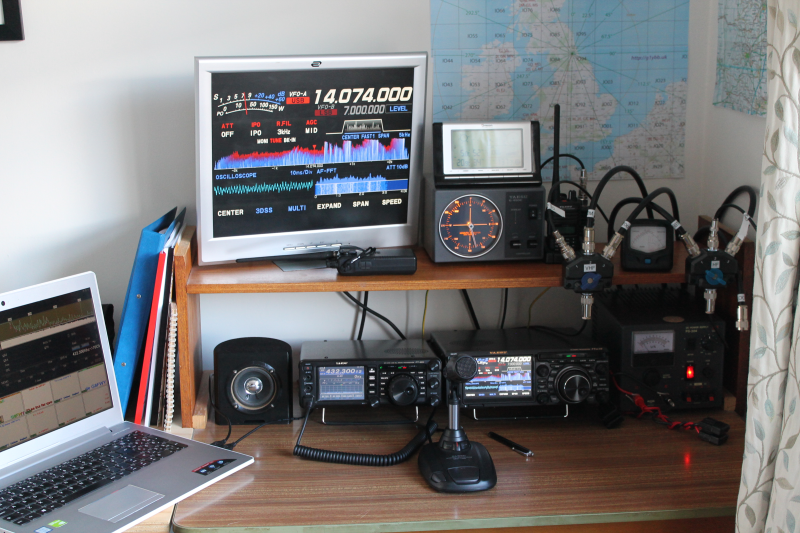
The shack, in a cosy corner of the dining room.
In order to reduce the load on the aluminium mast, I've removed the dual band collinear and replaced it with a tri-band (6m, 2m & 70cms) one and mounted it on the chimney stack. I've also got my weather station up there too.
There's a story to go with the collinear, but rude words and libel laws prevent me from printing it here!
The only other change has been to get a dual band mobile and antenna to match. I got an Anytone 778 VU and a Diamond 1/4 wave 2m & 70cm with mag mount.
Up to present, I've only used it a few times, but it seems to work well.
There's been another change to the shack.
A friend was moaning about the lack of space in his garage, due mainly to an old desk which he wanted to get rid of. Turned out that this was a modern reproduction of a Georgian writing desk which, when new, had cost about £800.
Suffice to say that it came my way and, after a bit of cleaning / restoration, now sits proudly in my dining room and houses all my ham radio gear.
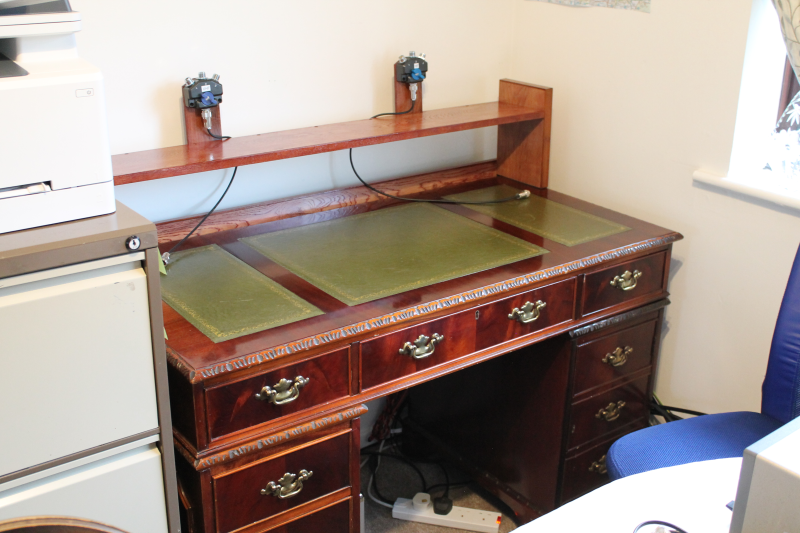
The new desk installed in position.
I intended to put a shelf across the back of the desk - a bit like the previous installation and I thought - in my ignorance - that it should be easy to get some mahogany faced chipboard ( they used to call it conti-board and sold it by the mile! ). Well, I was wrong. You can't get it anymore.
So what about a mahogany plank? Now, I knew wood was expensive these days but... time to take out a second mortgage! So that idea got squashed too.
I settled on some oak finished laminate flooring, duly treated with mahogany woodstain and faced with mahogany ( yes, real mahogany! ) strip.
I have to say that I'm pretty pleased with the result. You just can't beat flame red mahogany.
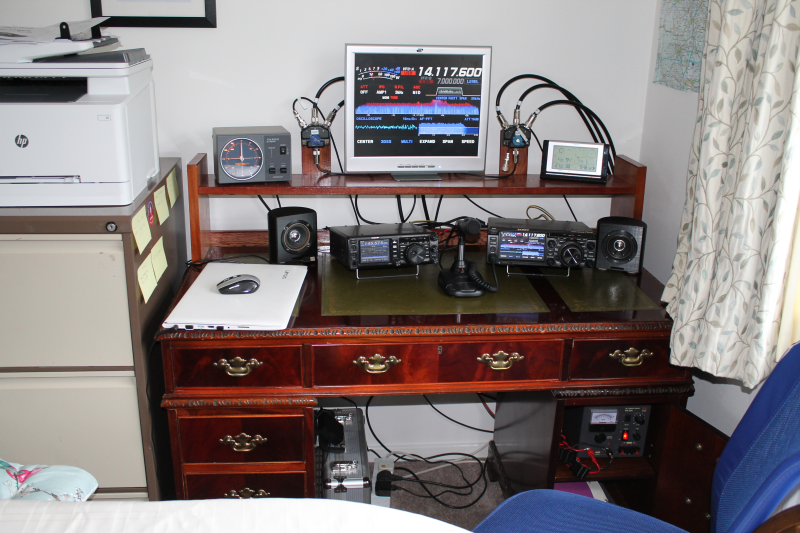
The shack, with everything installed.
After some time using the FT-991, I decided that it was a bit wasted, as I'm only using the VHF side of it. So I started the hunt for a VHF only all mode radio. I eventually chose the Icom IC-9700 which does 2m,70cm and 23cm. I also invested in a 36 element yagi for 23cm.
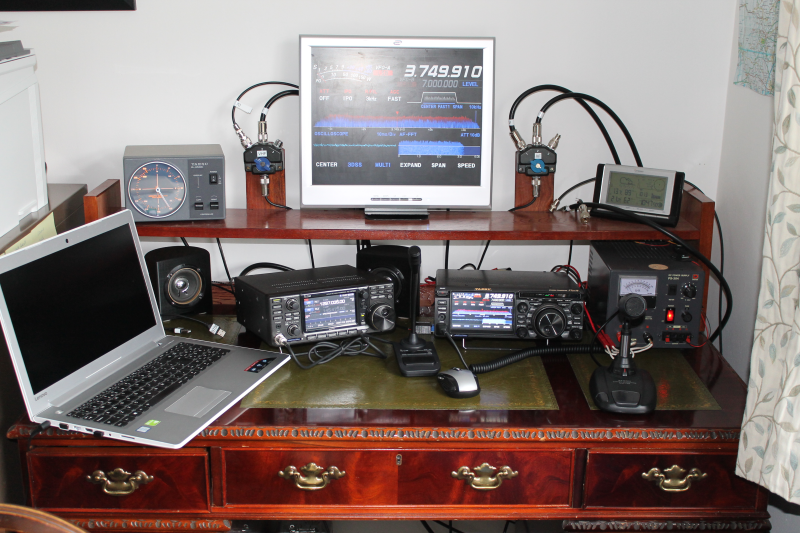
The new IC-9700
Antennas have also been moved around, the tri-band VHF vertical is now attached to the chimney and the 23cm yagi is at the top of the main stack. Surprise, surprise! I got bitten by the 23cm bug. I have recently purchased a 25w linear amp and pre-amp from SG Labs. It is now mounted in a diecast box along with a power supply and is about to be mounted at the top of the main mast. This should give me an erp of about 2.5Kw.
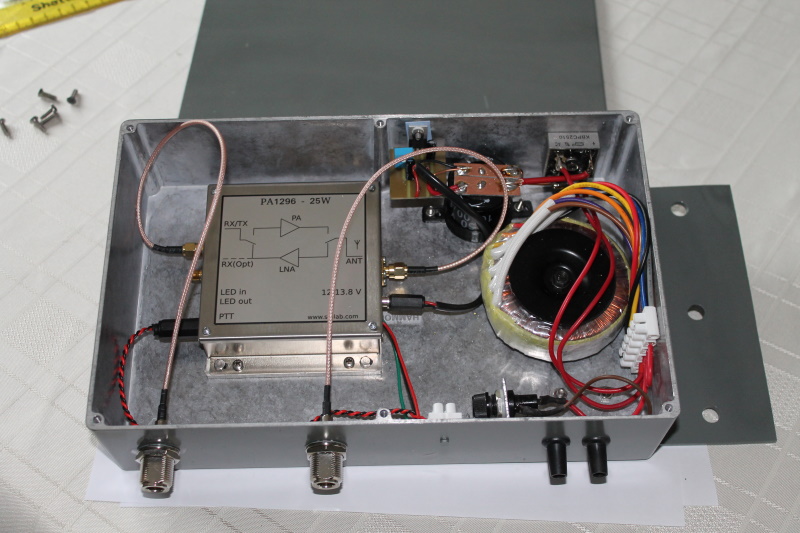
The 23cm linear amp ready to go up the mast.
I was also a bit concerned that I had nothing to measure power at this frequency, so I built up a power meter (a la PA0RWE) using an AD8318 board - yes, from China! This will cover from HF up to about 8Ghz. I also had to invest in some attenuators as the power meter can only handle signals in the -40dbm to -10dbm range.
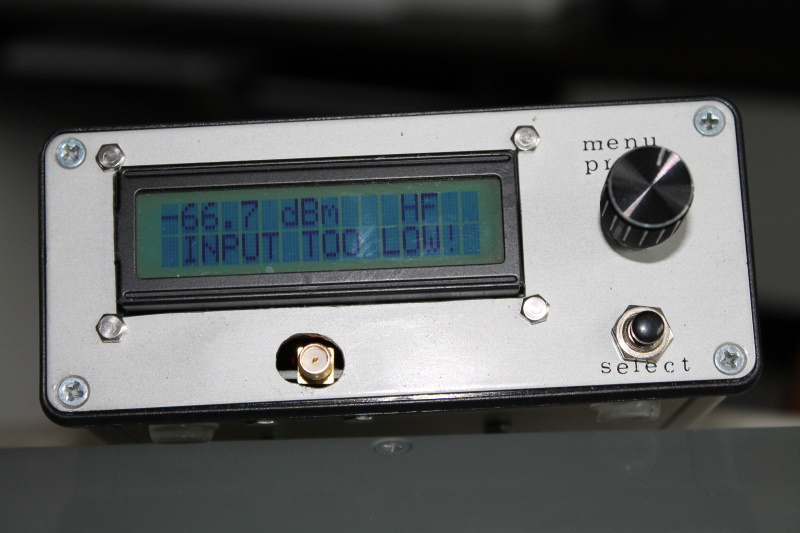
The new power meter.